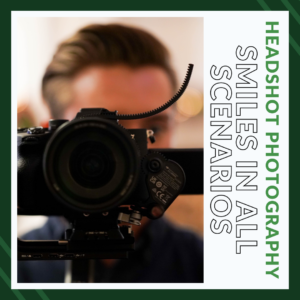Headshot Photography: Smiles in All Scenarios
 Imagery is a powerful tool that can provide people with a sense of familiarity and connection to people they haven’t met before. One of the most common forms of photography sets itself up perfectly for this connection: headshots and portraiture.
Imagery is a powerful tool that can provide people with a sense of familiarity and connection to people they haven’t met before. One of the most common forms of photography sets itself up perfectly for this connection: headshots and portraiture.
A conventional headshot can serve as a warm invitation to learn more about an organization or agency and help promote further engagement. But how can photos like these be achieved? With proper execution of lighting, angle and location, a headshot can bring people into the world of your organization!
Lighting
Lighting is possibly the most important aspect when it comes to portrait photography; soft, even lighting offers the best perspective on a subject and shows the most amount of detail that matters. Appropriate lighting on the eyes and smile helps people to look at a photo more carefully.
Using large sources of light, like the sun or studio-type lighting, can help to achieve this look, however, the main issue with powerful lighting is controlling how it falls on a subject. Smooth out powerful light sources by using diffusion filters, such as thin silk or cloth.
The position of the lighting is important, too. Lights should face a subject straight on or at a slightly higher angle, but never from directly above. Even with diffusion, overhead lights can cause shadows under the eyes, nose and neck.
Pro Tip: Smooth, even lighting can be achieved by shooting outside in the shade with a bright-colored building nearby. This technique allows for light to bounce off the building and onto your subject, creating a soft light source.
Angle
Using the proper angle and posture for portrait photography will help make a subject look their best. Whether sitting or standing, ensure that the person’s back is straight, their shoulders are slightly relaxed and that they feel comfortable. Along with this, the camera’s position should line up with the subject’s eyes, be raised slightly, and be tilted down toward the subject. The angle should be subtle and not too extreme.
Pro Tip: Having your subject sit on or near the edge of a stool will cause them to naturally sit upright.
Location
Finally, location is an important element of portrait photography. Some questions to ask when determining location might be:
- What type of backdrop works best?
- Is there already a style or look in place?
- Where can I tell the best story?
The location and background of photography can span from a backdrop, outdoor scenery or even inside an office. Each of these settings has its fair share of strengths and weaknesses, as well as an impact on the feeling of the portrait.
Using a backdrop will allow for a group of people to cycle through photos at a quicker rate because the factors of lighting and the background will not change as they could with another option. The consistency of the background will also create a sense of uniformity across all headshots and can be interpreted as an incredibly professional look to an audience. Typically backdrops need separate lighting to illuminate the subject and the background. The need for editing might be present depending on the style of backdrop used. However, having a complete set of photos that look identical does present organization and professionalism.
Determining outdoor scenery can prove difficult due to changing factors like lighting and season changes. The sun is constantly moving throughout the sky, causing changes in shadows and the best positioning for the subject. The scenery is dynamic in the way it looks, too; public places are always progressing from small details to obvious changes. Portraits with an outdoor setting give the audience a sense of location that is unique and recognizable, which is a big reason to take a photo without a staged background. Placing a subject in a setting that is meaningful to them may tell a bigger visual story than simply a headshot.
Finally, using an indoor office as the background displays a corporate appearance with a sense of identity. Signage can be used to signify where a person works, which may be important to the photo. Because the portraits are taken inside, control of the lighting and background is easier. Using lighting to emphasize the subject and elements in the background can be taken advantage of. Keep in mind that the photos may also lose the intrigue of an outdoor setting, yet can still have a sense of uniformity similar to using a backdrop.
Pro tip: Location scouting beforehand provides context for the photographer and the chance to dial in where a photo can look its best.
With proper preproduction techniques and thoughtful intent, connection through imagery can be created. Tying headshots to your organization can motivate a deeper connection to your community that opens the door to engagement.


